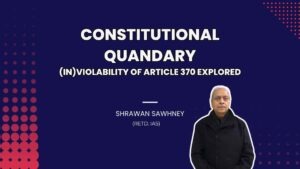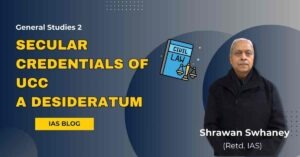Sedition in India - A Historical Retrospect
Sedition in India - A Historical Retrospect
Sedition is perhaps the very vaguest of all offences known to the criminal law. The offence of sedition was pitchforked in the news recently, be it “Delhiriots” during President Trump’s visit in February this year: be it the “Tukade-Tukade” gang of JNU which advocated fragmentation of India, or be it the prosecution of dissident MLAs in Rajasthan in June-July this year under Section 124-A of the Indian еnal Code, 1860.
It was rightly observed by Counsel Paulus Pleydell in “Guy Mannering; or The Astrologer” (a second of the Waverly novels by Sir Walter Scott) that “a lawyer without history or literature is a mechanic, a mere working mason: if he possesses some knowledge of these, he may venture to call himself an architect. For analytical jurists the present is more important, for philosophical jurists the future, but the historical jurists attach greater importance to the past. Law is not a disjointed phenomenon or a static entity but an organic and a living mechanism to keep pace with society. Let us track down the historical evolution of the offence of ‘sedition’ in India.
The offence of sedition was extant in ancient India. Dharma-Sutras” bear ample testimony to this. From very early times, the lawgivers treated the king as the embodiment of the state. There were two entities – one the king, the individual and two the kingship, the institution- which represented the state. Arthur Coke Burnell. who has translated ‘Manu Smriti’ in “The Ordinances of Manu’, has cited Manu – the ancient lawgiver -to the effect that ‘a king is not to be despised….. (pp 227-228). Kautilya has also echoed similar views in his Artha Shastra (1.13). Even in such early works as the ‘Rig Ved’ there are hymns glorifying the office of king (Rig Ved IV 42). It should be noted that it was not the king but the kingly office that actually carried special dignity and sanctity and invoked re spect and any offence against this office was treated very severely indeed. For offences against the royal office Narada has prescribed monetary and corporal punishment (Narada Smriti, Parikirnaka, 13). The ‘Matsya Puran’ advocates aggravated punishment for interfering with the authority of the king (‘Matsya Puran’ 227.185). Brhaspati was much lenient and suggested lighter punishment for a person inimically disposed towards king (Brhaspati Smriti XVII).
It is significant that Kamandaka emphasised that there was no punishment, other than death, for the offence of subverting the state (Kamandaka Nitisara XIV 16). In Mudrarakshasa there is an instance of Sreshthi Canadandasa being taken to the execution ground for doing what was politically unwholesome Rajapathyakarinam (Mudrarakshasam VII). Manu has stated that in a king’s realm there is no thief, nor adulteror, nor libellor. According to Burnell libellor’ here means ‘one with an injurious voice and sentiments towards the king’ (“The Ordinances of Manu’ p. 239). Medhatithi has opined that no communication must be had with the man who excites hatred towards the king nor should he be allowed to en ter the house. Disloyal feudatories were kept under check after the failures of rebellion and were subjected to various indignities (Epigraphia Indica XVIII pp. 43-46). It is quite clear that royal policy measures were not always liked by the people and that some political crimes were committed during outbursts of resentments. Thus, our ancient legal texts prohibited the people from despising and diffusing hatreр against the office. There are various references to instances where people were punished for exciting disaffection towards the king (Mrcchhakatikam VI). The ancient regimes in our country realised that a government n has the right to object when its populace wander off from criticism to calumny. Those who excited evil prejudices and stirred up discontent against the king and the kingdom were the producers of mischief of the gravest character. Those who distilled and sold the poisonous product of ferment to saturate the gullible masses with evil thoughts of king and kingdom were repressed with a strong hand. During the medieval period there was a disintegration of the ancient Indian empire. Muslim invaders captured our territory and a cultural conflict ensued wherein the ancient legal mores were subdued. Consequently, the laws of these invaders held sway and added to the extreme fluidity of the contemporary legal system. Muslim laws had an ethico-religious tinge and were prone to subjective application. Strictly speaking, Islamic law did not have a distinct corpus of “criminal law”. It divided crimes into different categories depending on the offence. Huddud were crimes against God. Their punishment was prescribed in the Quran and Hadiths. Qisas were crimes against an individual or family Their punishment was equal retaliation as per the Quran and the Hadiths. Tazir were crimes whose punishment was left to the discretion of the ruler or judge. Siyasah were crimes against the government. The offence of sedition, as such, was not in vogue but we find instances of revolt by the Muslims themselves against their rulers. Aram Shah provoked rebellion against the regime of Altmish. Similarly, re bellion incited by Ali Mardan. again against Altmish, was quelled. Razia Sultana had to suppress the upsurge of soldiers against her regime. It is, therefore, noticeable that the offence of exciting disaffection, which included disloyalty and all feelings of enmity, against the Muslim rulers was not unknown in the medieval period also. Any incitement and disparaging exhortation against the Muslim kings was dealt with an iron hand.
By: Shrawan Sawhney (IAS Retd.)
The Views expressed by the author are personal.
Notes on Sedition in India - A Historical Retrospect
🧭 Introduction
Sedition is one of the vaguest and most controversial offences in criminal law.
Recently invoked in high-profile cases: Delhi riots, JNU “Tukde Tukde” slogans, Rajasthan political crisis.
Central statute: Section 124A of IPC (Indian Penal Code, 1860).
📜 Historical Evolution of Sedition Law in India
🏛️ Ancient India
Law and morality intertwined through Dharmashastras.
The king (raja) was seen as the embodiment of the state; loyalty to the kingship (not the individual king) was expected.
Key Textual References:
Manu Smriti: “A king is not to be despised.” (Burnell translation).
Kautilya’s Arthashastra (1.13): Advocates strict punishment for sedition-like acts.
Rig Veda (IV.42): Hymns glorify kingship.
Narada Smriti: Prescribes corporal and monetary punishment for offences against the royal office.
Matsya Puran (227.185): Advocates aggravated punishment for subversion of royal authority.
Kamandaka Nitisara (XIV.16): Death penalty for subversion of state authority.
Brhaspati Smriti: Suggests leniency for subjects critical of the king.
Medhatithi: Advocates social ostracism of those who excite hatred against the king.
Dramatized Example:
Mudrarakshasa: Character Chandandasa executed for politically unwholesome conduct.
Interpretation:
Criticism was tolerated to some extent, but sedition (destructive criticism) was punishable.
Ancient societies recognized the danger of inciting hatred or disaffection against the state.
🕌 Medieval India
With Muslim rule, ancient Indian legal mores gave way to Islamic law with a theocratic foundation.
Islamic Legal Categories:
Hudud – Crimes against God.
Qisas – Crimes against individuals (eye for an eye).
Tazir – Discretionary punishment.
Siyasah – Crimes against the government (closest to sedition).
Notable Rebellions:
Aram Shah vs. Iltutmish
Ali Mardan’s rebellion
Soldier uprising against Razia Sultana
Interpretation:
Though sedition as a legal term didn’t exist, any incitement against the ruler was treated as rebellion and suppressed.
📜 Colonial and Modern Context (Brief Mention)
Although not elaborated in the article, sedition in colonial India was formally codified under Section 124A IPC by the British in 1870.
Historically used to suppress nationalistic dissent (e.g., Bal Gangadhar Tilak, Mahatma Gandhi).
Present use is criticized for being vague and prone to misuse, especially against dissenters, activists, and political opposition.
🧠 Analytical Insights
1. Continuity of Concept:
Ancient to modern India: Offences against the symbol of state authority have always been punished—initially through religious/moral codes, later through codified law.
2. State vs. Individual:
Historical emphasis was on protecting institution of kingship/state, not the personality of the king.
3. Purpose of Law:
Sedition laws historically aimed to maintain social harmony and political order but can transform into tools of suppression if not monitored.
4. Need for Reform:
Relevance of sedition law in a modern democratic setup is questioned.
Mains-Based Questions on Sedition in India - A Historical Retrospect
1. Question:
“Trace the historical evolution of the concept of sedition in India. How has its interpretation changed from ancient to modern times?”
Answer Framework:
Introduction:
Define sedition: Act of inciting disaffection against the state.
Mention current relevance due to recent political cases and its roots in IPC Section 124A.
Body:
Ancient India:
Kingship seen as sacred (Manu, Kautilya, Rig Veda).
Any offence against the institution of the king was punishable.
Death penalty or corporal punishment for subversion (Kamandaka, Narada).
Role of dharmashastras in sustaining royal authority.
Medieval India:
Islamic jurisprudence introduced: Hudud, Qisas, Tazir, Siyasah.
Rebellions against rulers like Iltutmish, Razia Sultana dealt with forcefully.
No codified sedition law, but any disaffection was treated as rebellion.
Colonial India:
Section 124A introduced in 1870 to suppress nationalistic voices.
Used against leaders like Bal Gangadhar Tilak, Mahatma Gandhi.
Sedition equated with political dissent.
Post-Independence India:
Retained in IPC; upheld by SC in Kedar Nath Singh (1962) with limitations: only incitement to violence punishable.
Criticized for misuse against activists, journalists, dissenters.
Conclusion:
Law must evolve with democratic values.
Sedition law should be reassessed in the light of free speech under Article 19(1)(a).
2. Question:
“Do you think sedition laws in India are a colonial relic that need to be repealed? Critically analyze in the historical context.”
Answer Framework:
Introduction:
Mention sedition’s colonial origin; currently under debate for relevance in democracy.
Body:
Historical Legacy:
Ancient & medieval texts punished disloyalty to rulers, but within religious or moral frameworks.
British codified sedition in IPC Section 124A explicitly to curb political resistance.
Post-Independence Retention:
Despite independence, sedition law was retained.
Kedar Nath Singh (1962) upheld constitutionality with safeguards.
Modern Misuse:
Misused against journalists, students, and dissenters.
Vague terminology like “disaffection,” “hatred,” open to misuse.
Law Commission & SC have raised concerns.
Arguments for Repeal:
Colonial intent incompatible with democracy.
Alternatives available in UAPA, NSA for dealing with genuine threats.
Suppresses freedom of speech and expression.
Arguments for Retention (with reform):
State needs protection against incitement to violence.
Can be retained with clearer definitions, safeguards.
Conclusion:
Sedition law, rooted in colonial repression, must be re-evaluated.
Repeal or reform should ensure protection of state without compromising democratic freedoms.
3. Question:
“How did ancient Indian texts conceptualize offences against the state? Do they justify the continued use of sedition laws today?”
Answer Framework:
Introduction:
Mention how sedition-like concepts existed even before colonial law in India.
State that ancient texts considered the king a sacred institution.
Body:
Ancient View:
Manu, Kautilya, Rig Veda: Reverence to king’s office.
Disaffection punished harshly (Narada Smriti, Kamandaka).
Offences were moral-religious violations, not criminal statutes.
Intent Behind Punishment:
Maintain harmony, prevent anarchy, preserve dharma.
Prevent ferment of hatred in masses against authority.
Difference from Modern Law:
Ancient laws were personal, monarch-based.
Modern state is constitutional, impersonal, bound by rule of law.
Modern sedition law punishes speech in a democratic setup, often silencing dissent.
Relevance Today:
Ancient justification cannot apply in a democratic framework.
Today, criticism strengthens democracy, unlike monarchies where it was destabilizing.
Conclusion:
While ancient texts show concern for state stability, their moral codes cannot justify colonial-era sedition laws in a democracy.
India must build laws aligned with its Constitution, not monarchy-based heritage.
4. Question:
“Discuss the tension between national security and freedom of speech in the context of sedition law.”
Answer Framework:
Introduction:
Mention growing use of sedition law against critics of the state.
Touch upon constitutional guarantee under Article 19(1)(a).
Body:
Freedom of Speech:
Fundamental right.
Allows criticism, dissent, and public debate.
Essential for democratic accountability.
National Security Argument:
State must protect itself from secessionism, incitement to violence.
Sedition law invoked to prevent threats to sovereignty and unity.
Judicial Balancing:
Kedar Nath Singh (1962): Upheld sedition only for incitement to violence.
Not applicable to mere criticism of government policies.
Challenges:
Vague law leads to misuse.
Used more to harass than convict (low conviction rates).
Chills free speech and creates fear among dissenters.
Alternatives:
Use existing laws like UAPA, NSA in grave cases.
Clarify “reasonable restrictions” under Article 19(2).
Conclusion:
India needs a mature legal approach that balances security concerns with democratic freedoms.
Repealing/reforming sedition law is essential to protect both national integrity and citizen rights.
Prelims Questions based on Sedition in India - A Historical Retrospect
-
Constitutional Quandary: Inviolability of Article 370 Explored
Upon adoption of the Constitution of India, the preamble proclaimed,... -
Decoding Article 370 – A Historical Retrospect
The Apex Court is currently hearing petitions disputing the amendment... -
Sedition In India-Modern Era
English inhabitants in India requested the then Indian rulers to... -
Sedition In India – A Historical Retrospect
Sedition is perhaps the very vaguest of all offences known... -
Contours of Free Speech
Recent a spate of cases against stand-up comics Munawar Faruqui,... -
Generation-Z And Clout Culture
Generation Z, also known as Gen Z-ers and Zoomers, is... -
Community Resources :An Equitable Landscape
Community Resources: An Equitable Landscape Table of Contents Blog - Community... -
Federalism and the Covid-19 Pandemic: A Constitutional Perspective
Recently, an article in a leading English national daily made... -
Uniform Civil Code – A Historical Perspective
Article 35 of the draft Constitution of India provided that... -
Secular Credentials Of UCC – Shrawan Sawhney
Recently, the 22nd Law Commission of India has set the...











